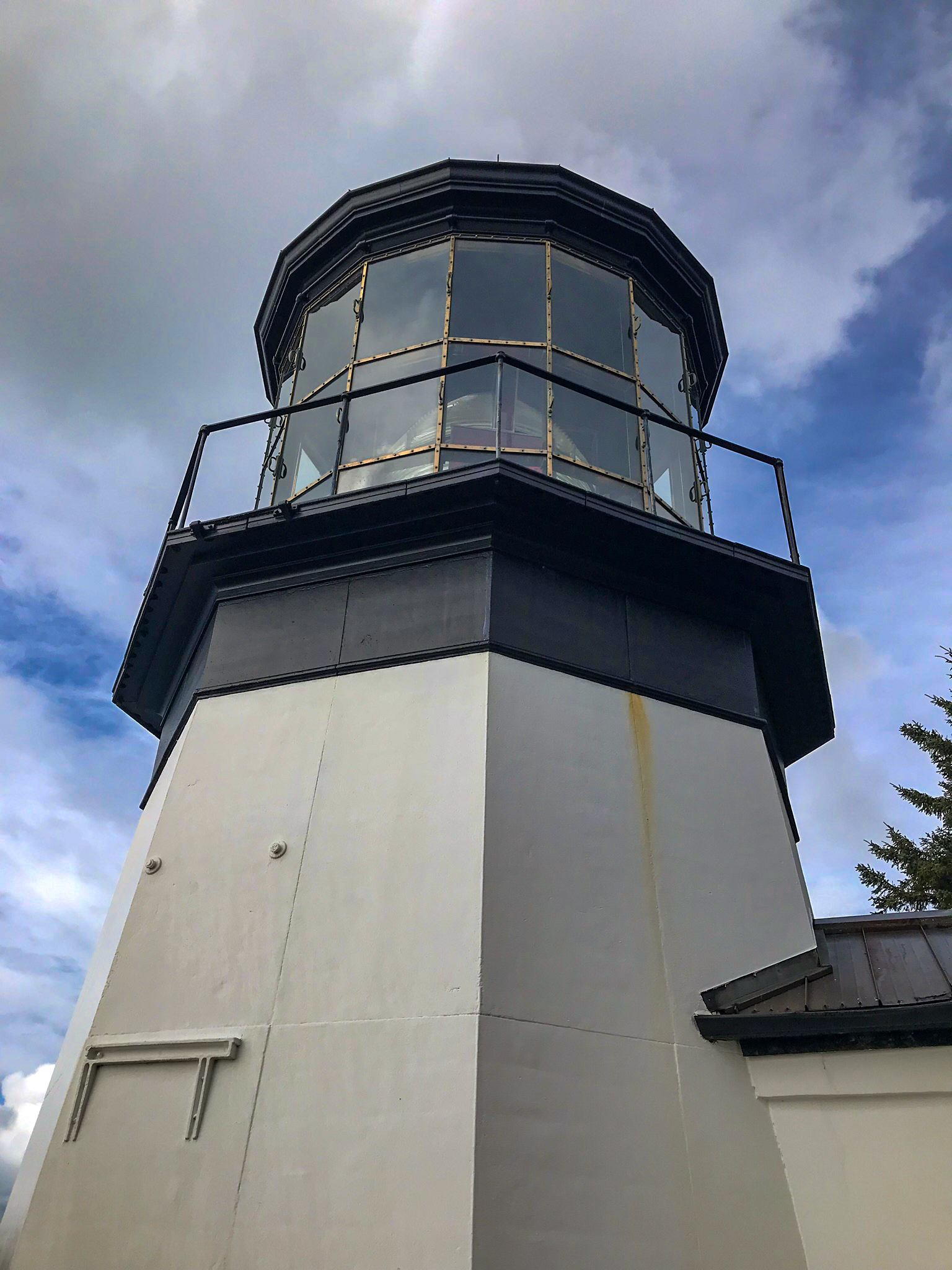11 miles outside of Tillamook Oregon sits Cape Meares Lighthouse, offering beautiful views of the Pacific and a glimpse into The Oregon Coast’s shortest lighthouse.
Cape Meares, a Staple on the Oregon Coast

The Cape Meares lighthouse isn’t known for standing tall on the Oregon Coast, but was a crucial part of keeping ships safe for nearly a century of maritime history.
When in operation, The Cape Meares lighthouse was well known on the Oregon Coast for its signature red and white light. The 38-foot iron-plated structure featured an oil lamp and a reflector to maximize the lifesaving illumination, and warned passing ships of coastal dangers with 30 seconds of white light followed by 5 seconds of red light. Cape Meares is also one of the few lighthouses that never had a foghorn.
The History of Cape Meares Lighthouse
Built in 1889, and commissioned in 1890, Cape Meares lighthouse was built to guide ships along the jagged Oregon coast and into Tillamook Bay. Accompanying the lighthouse construction were two keeper’s houses. To store the oil that kept the light in operation, two oil storage buildings were also built on the cape, east of the lighthouse. Both were constructed with thick walls to protect the surrounding land in case of fire.

In 1934, electricity was brought to the Cape Meares lighthouse, and the oil buildings were removed. In 1963, the lighthouse ended its career guiding ships on the Oregon coast and was decommissioned.
Essentially abandoned, the Cape Meares lighthouse succumbed to the relentless weather of the Oregon coast, as well as rampant vandalism. Through it all, the lighthouse continued to stand.
Finally, the site was gifted to the Oregon State Parks Department in 1968. During this period, the department renovated the lighthouse and restored many aspects to their original state, including repairing damage from vandals. This restoration included rebuilding the replica of the 1895 workroom, which had been previously demolished. Unfortunately the lighthouse keeper’s quarters had to be demolished thanks to ensuing damages, and a few lenses from the lighthouse were replaced before the site was open to the public, as it is today.
Visiting Cape Meares on the Oregon Coast
Today, the Cape Meares Lighthouse site is tourist friendly and features ample parking. Just next to the parking lot is a wooden deck built up for ideal viewing of the waves crashing into the cliff face. The railing features plaques explaining information about the area.

From here, you walk down a paved pathway that takes you through a forest of trees. A small opening contains another educational viewing area and has plaques about native wildlife, specifically sea birds of the Pacific Ocean. The pathway continues straight down to the tiny lighthouse, another pathway leads down the other edge of the cliff face and eventually to Cape Meares Lighthouse from the side.
When you first happen upon the lighthouse, it is surprising how short it is. From the back, it almost seems as if it is built on a cliff face much lower. The next thing to draw you in is the stunning red color in the glass.
In fact, Cape Meares is know for its red and white lights. The alternating patter served as a distinct navigational aid, helping mariners identify the specific location and to warn them away from hazards on the coast. The technology used to achieve the alternating red and white flashes was considered advanced at the time. Four sides of the lens were covered in red glass panels, which would rotate in front of the light source, creating the alternating pattern.
The Cape Meares lighthouse is a crucial scenic destination on the Oregon Coast that is still standing thanks to those who fought to save it.
Take Time to Visit the Octopus Tree

As you walk the scenic loop around Cape Meares Lighthouse, you’ll encounter more than stunning views of the Pacific ocean and rocky northern Oregon coast.
Nestled near the iconic Cape Meares Lighthouse on the Oregon coast, stands a unique marvel – the Octopus Tree. This aptly named conifer of disputed origin isn’t your average tree. Its contorted branches resemble the writhing tentacles of an octopus, reaching out towards the coastline.
While he true identity of the Octopus Tree is still a subject of some debate, (it is most likely a Shore Pine (Pinus contorta contorta), most experts agree that the harsh winds and salty spray the tree has endured for centuries, have shaped the tree’s remarkable growth.
The Octopus Tree has become a beloved symbol of Cape Meares, capturing the imagination of visitors with its whimsical form and resilience. It serves as a testament to the enduring power of nature and its ability to shape the world around us in unexpected and captivating ways.
Take the Nearby Cape Meares Loop
For stunning vistas and a tremendous climb, consider detouring to the Cape Meares Loop road.
For decades, this steep roadway provided crucial access between Cape Meares and Oceanside to the north. That all changed in 2013, when a major landslide forced the road to close. A geological review concluded that this portion of the roadway had been constructed on an active slidezone, identified on maps as early as the 19th century.
To avoide future slides, the roadway was closed and a massive construction project commenced. The Cape Meares Loop road was reopend in 2023, to significant fanfare.
The new road features 12% grades and a scenic alternate route for travelers heading north to Astoria. The significant elevation provides dramatic views of the Oregon coastline with a panoramic viewpoint where drivers can stop to enjoy the beauty of the rugged coast.
LOCATION
Tillamook, Oregon
TRIP LENGTH
15 minutes to 1 hour
THINGS TO DO NEARBY
Tillamook Cheese Factory- 30 minutes away
Drift Creek Falls- 1 hour 50 minutes
Astoria Oregon- 2 hours away
Astoria Column Glider Flights- 2 hours away




